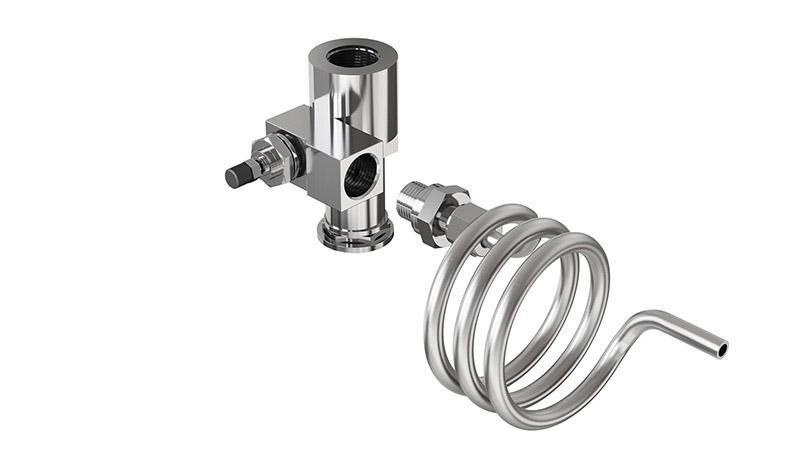
Compressed air sampling for moisture detection
Compressed air sampling best practices for measuring dew point

Sampling is needed when direct measurement of the air is undesirable or is simply not feasible. This may be due to a high process temperature, the need to protect the sensor from water spikes, the added convenience of installing and removing the instrument from a pressurized process without shutting down the line or wanting to take the measurement in a more convenient location.
To get a representative sample of the process gas and avoid potential sources of error caused by incorrect sampling practices, a few aspects should be considered:
1. Acknowledging the effect of the gas pressure on the dew point temperature of the gas
It is important to keep in mind that changing the gas pressure changes the dew point temperature of the gas. If the sensor is at a different pressure than the process itself, an error of several tens of degrees dew point may be apparent. Generally, the measurement should be taken at the actual system pressure to avoid pressure drops in the sampling system. Exceptions can sometimes be made when standards require reporting the dew point at ambient pressure, thus excluding the effect of pressure fluctuations.
2. Avoiding condensing water in the sample line
When the need for sampling is due to a high process gas temperature prohibiting direct measurement, it is important to ensure that the dew point level of the process is lower than the ambient temperature to which the sample gas is cooled in the sampling line. This prevents water vapor in the sample from reaching saturation causing liquid water to form in the sample line. In cases where the dew point is higher than ambient temperature, either a direct measurement or a heated sampling line is required.
3. Ensuring a leak-tight sampling system and materials
Due to the very low level of humidity typically found in compressed air and gas systems, dew point measurements are highly sensitive to even the smallest leaks in the system. Consequently, the importance of having a leak-tight sampling system is critical. All connections should be tight and sealed correctly. For tapered threads like NPT, use of Teflon tape is recommended. For straight thread connections such as G 1/2”, the sealing washer provided with the instrument should be installed between the probe and the sample cell.
Careful consideration should always be given to the sampling system’s material of construction since water vapor diffusion through the pipe or tubing walls can occur. The piping should preferably be made of metal, e.g., stainless steel with a good surface finish. Hygroscopic material such as rubber hose and plastics is undesirable and should be avoided. PTFE or Teflon is one exception that is a rather vapor tight plastic and can be used down to a dew point level of about – 40 °C (-40 °F). Sample tubing should be as short in length as possible and “dead ends” should be avoided. Also minimizing the number of connections helps in avoiding leaks. If possible, prepare the sampling system for the measurement by purging it with the dry process gas sufficiently to ensure a faster stabilization and response time.
4. Considering the flow-rate
Stagnant air can be a problem for a few reasons:
- A representative sample of the process air may not be obtained.
- Response time may be dramatically impaired.
- The risk of ambient air leaking or diffusing through sampling materials increases.
Back diffusion of ambient water vapor through the outlet port of the sample cell can occur. Using a dew point sensor that is not dependent on flow rate is strongly recommended. Although higher flow rates generally improve the sensor response time, flows of 1-2 l/min (0.035-0.7 ft3/min) are typically enough for high-quality sensors.
5. Select the right probes and sample cells
Read the Compressed air dew point sampling application note including details of the compatible probes and sample cells as well as the best practices mentioned above!
Looking for dew point measurement instruments for compressed air?
Our instrument offering covers the full dew point temperature measurement range for nearly any compressed air system. Read more about our products incorporating the unique Vaisala DRYCAP® sensor technology and download useful compressed air measurement resources.